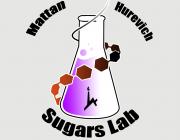We develop automated approaches for the synthesis of complex oligosaccharides. We use the uniqe Glyconeer synthesizer to enable us to access oligosacchrides in record yield and speed. We use well defined sulfated saccharides for sensing heavy metal ions in solutions.
- AGA
Carbohydrates, also known as glycans or saccharides, are the most abundant biopolymer in nature. Oligosaccharides are short glycans that have multiple biological functions that are derived from their composition, size, and specific linkages architecture. Synthesis of oligosaccharides is the best way to study their interactions and to develop a variety of applications. The synthesis of oligosaccharides is very complicated as it requires installing multiple linkages between the monomers with precise stereo and regio-selectivity. We develop an automated approach to synthesize oligosaccharides. In this effort, we study the role of protecting groups in the formation of glycosidic linkages and participate in the global endeavor to find the optimal building blocks and conditions to facilitate the accessibility to those elusive entities.
- Photochemistry
Photochemical reactions are Intriguing synthetic transformations. The ability to use light sources with highly defined energy thereby create and break chemical bonds is extremely valuable in organic chemistry. Our group develops and uses photolabile protecting groups and linkers for carbohydrate chemistry. We have been manipulating photolabile protecting groups of various glycans and showed that using 365 nm LED light we can remove a large number of them simultaneously in a very short time. We use photolabile linkers to connect between the glycan and the solid support which is used for automated glycan assembly. We develop fast and efficient strategies to cleave the glycan from the support using light irradiation. We continue and develop this technology to provide a high yield alternative to common cleavage and protecting group methods.
- sulfated glycans
Sulfated saccharides are enigmatic and highly abundant molecules. They play a massive role in the extracellular matrices of our cells and also in many other organisms such as algae plants and more. Sulfated saccharides take a key part in the interaction between cells and in recognition events. The sulfation of saccharides provides them with new properties that influence their biological function. Sulfation patterns are highly versatile, they are related to specific origin and tissue and are highly sensitive to environmental changes, toxic entities. and many more. We develop tools to synthesize and study the interactions of sulfated saccharides. We use a specific protecting group’s hierarchy to enable the assembly of oligosaccharides with distinctive sulfation patterns. We harness our know-how in glycosylation and solid-phase strategies to automate the synthesis of sulfated saccharides. In parallel, we develop new electrochemical tools to study the interactions of these saccharides. We focus on elucidating the effect of sulfation patterns of metal ion interactions and metal ion mediated protein interactions.
- Sialosides
Sialic acids are special negatively charged nine-carbon monosaccharides. Sialic acids decorate O- , N –glycans, and gangliosides. Sialic acids play a crucial role in cellular recognition, interactions, and adhesion. Sialylation and desialylation, the assembly or removal of sialic acids, are crucial enzymatic transformations. The function of these enzymes is associated with disease state, pathogen invasion, neuro- and immuno-diseases, and genetic disorders. Because the accessibility to well-defined sialylated glycans, sialosides, is very limited, the biological role and the specific interaction between sialosides and sialylation-related enzymes is understudied. We combine surface chemistry strategies, electrochemical sensing methods, and synthetic know-how to build new tools to study the interactions of sialosides and related enzymes and binding proteins. The developments of these tools bring us closer to finding new inhibitors and treatments for sialic acid-related virus infection.

